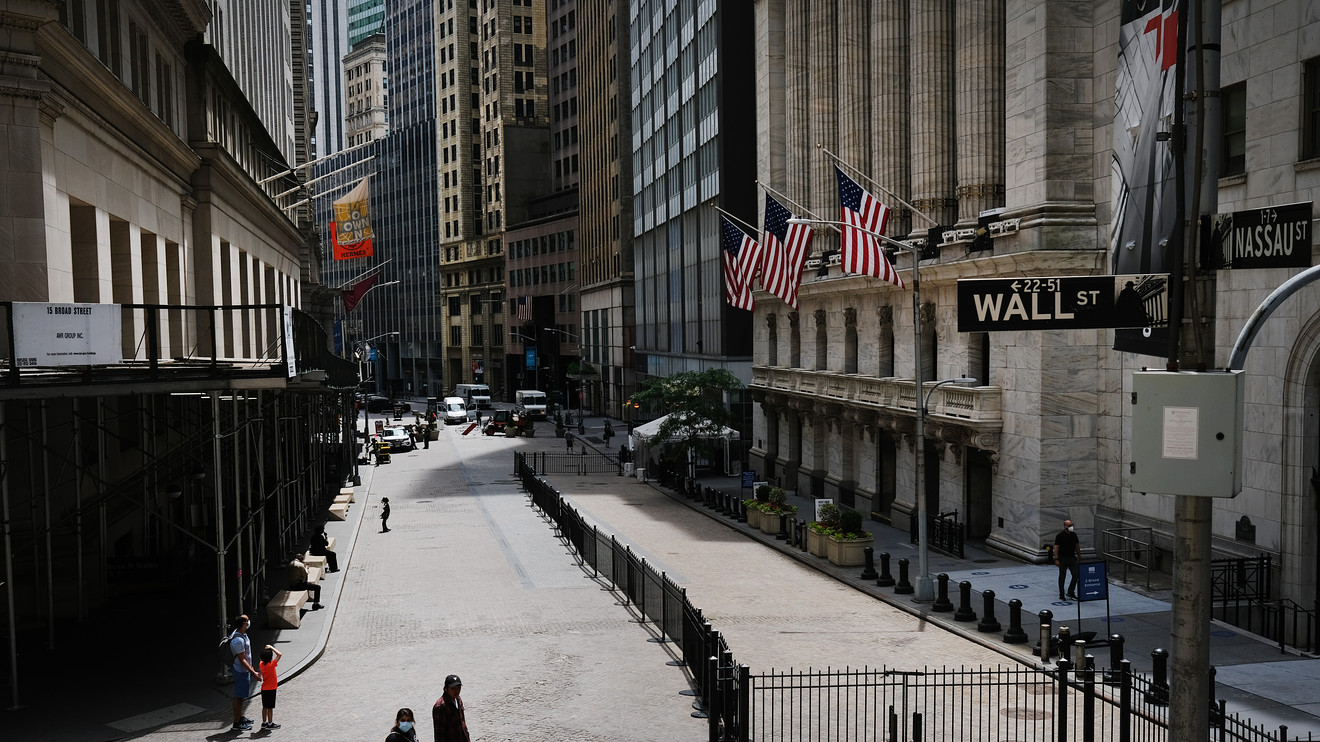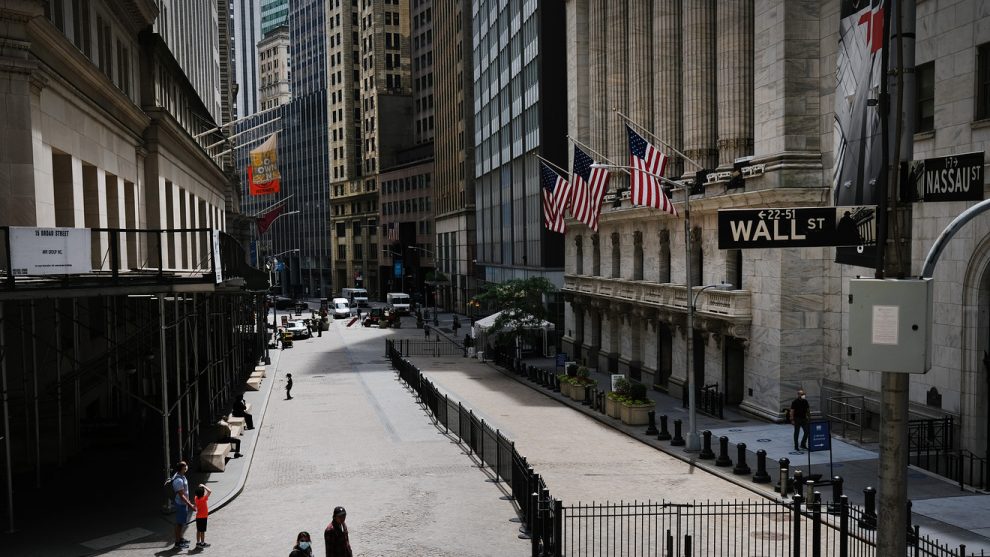
U.S. stock-market indexes traded slightly lower, but were attempting to regain their buoyancy, Monday morning, as investors weighed optimism over a quick recovery for the domestic economy, or V-shaped rebound, against evidence of an acceleration of COVID-19 infections in states and elsewhere in the world.
Investors, however, were buying technology-related stocks, which could help to propel Wall Street stocks higher on the session.
How are benchmarks performing?
The Dow Jones Industrial Average DJIA, +0.24% was trading 18 points, or 0.1%, lower to around 25,867, but had been down by nearly 204 points at the start of Monday trade. The S&P 500 SPX, +0.26% was trading virtually unchanged, or less than 0.1%, to 3,096, off its intraday low at 3,079.26, while the Nasdaq Composite COMP, +0.39% picked up 14 points, or 0.1%, to around 9,957.
On Friday, the Dow closed 208.64 points lower, down 0.8%, at 25,871.46, after being as much as 371 points higher at an intraday peak at 26,451.44. The S&P 500 index fell 17.60 points, or 0.6%, to close at 3,097.74, but hit an intraday peak at 3,155.53. The Nasdaq Composite Index added 3.07 points, less than 0.1%, to close at 9,946.12.
Last week, Dow booked a weekly gain of 1%, the S&P 500 gained 1.9%, and the Nasdaq returned 3.7%.
What’s driving the market?
Cases of the disease caused by the novel strain of coronavirus picked up momentum as states and countries continued business reopening efforts over the weekend. That could prompt local governments to reinstitute restrictions on social activities, or stall plans to ease lockdown measures further.
“Significant business and economic risks remain as long as the health risk is unmanaged. In many U.S. states, COVID-19 case rates are rising, and [economic data] could quickly reverse if lockdowns are renewed or anxious individuals stay at home,” said Lauren Goodwin, economist and multi-asset portfolio strategist at New York Life Investments, in a note.
The World Health Organization on Sunday reported the largest single-day increase in cases, more than 183,000, in COVID-19, while South Korea on Monday declared its resurgence of the deadly virus a “second wave.”
Domestically, there are 24 states that showed an increasing trend in cases this past week, with California, Texas and Florida continuing to leading the way, each with more than 4,000 new cases on Sunday alone, according to data aggregated by Johns Hopkins University. The global tally for COVID-19 rose to just shy of 9 million, according to the day.
Overall, the U.S. continues to lead the world, with the case tally of 2.28 million and death toll of 119,977 more than double the next highest totals of 1.08 million cases and 50,591 deaths in Brazil.
Meanwhile, Germany’s rate of infection over a four-day average climbed on Sunday and India’s death toll rose by 445, its highest single-day tally, as the country reported 14,821 new cases, according to reports.
“There are clearly some concerns circulating, but they are nothing like the panic that was seen in February and March,” wrote David Madden, market analyst at CMC Markets UK, in a Monday research note.
Still, New York City is allowing companies to reopen their offices Monday after a three-month lockdown because of the pandemic.
White House trade adviser Peter Navarro said the Trump administration is preparing for a second wave of but isn’t anticipating one. “We don’t necessarily expect a second wave but prudence dictates that we plan for it. There is no contradiction,” he told CNN’s Jake Tapper on CNN’s “State of the Union” on Sunday.
A number of strategists, however, are betting that the economy, will stage a sharp rebound from out of recession, even as infections pick up. “History is not on the side of investors expecting anything less than a V-shape,” wrote analysts at Jefferies, led by Sean Darby, global equity strategist, in a research note, who is anticipating improvement in earnings as manufacturing data steadies from coronavirus lows.
Looking ahead, the Federal Reserve will release the results of its annual stress tests on the nation’s largest banks next Thursday Fed has conducted stress tests on the biggest banks every year since 2009 and this year is particularly important in the wake of the coronavirus pandemic.
“The bounce from near all-time lows in CASS shipments, ISM new orders minus inventories etc. is likely to cause S&P 500 earnings revisions to go into positive territory in early July,” referring to a monthly measure of freight shipment activity—Cass freight index—and manufacturing from the Institute for Supply Management.
In economic data, the Chicago Fed national activity index rebounded to a reading of 2.61 in May from a revised minus 17.89 in April. A number above a zero value for the index, which is a weighted average of 85 economic indicators, indicates that the national economy is expanding at its historical trend rate of growth. Negative values indicate below-average growth.
Later a report on existing-home sales is due at 10 a.m.
Which stocks are in focus?
- Shares of Apple Inc. AAPL, +1.63% are in focus the iPhone maker this week holds the first-ever virtual version of its Worldwide Developers Conference, an annual event that began in 1987. This year’s edition kicks off at 10 a.m. Pacific time. Its shares were up 0.9%.
- American Airlines Group’s stock AAL, -5.32% tumbled 6.2% after the air carrier announced Sunday that it would raise $3.5 billion in new financing.
- Tripadvisor Inc. TRIP, -4.12% said Monday that it expects June revenue to be about 20% of last year’s comparable period total. The stock was down 2.2%.
- Bed Bath & Beyond Inc. BBBY, +2.94% said it added a $850 million credit facility, and that it expected .nearly all stores to reopen by July. The stock was up 0.2%.
How are other markets trading?
West Texas Intermediate U.S. crude CLN20, +0.17% was down 40 cents, or 1%, to $39.35 a barrel. In precious metals, gold futures for August GCM20, +1.09% gained $15.30, or 0.9%, to $1,768.50 an ounce, on the New York Mercantile Exchange.
The 10-year Treasury note yield TMUBMUSD10Y, 0.683% edged 0.5 basis point lower to 0.694%. Bond prices move inversely to yields.
The greenback was down 0.2% against basket of its major rivals, based on trading in the ICE U.S. Dollar Index. DXY, -0.47%
In global equities, the Stoxx Europe 600 index SXXP, -0.67% was down 0.5%, while the FTSE 100 index UKX, -0.42% edged 0.3% lower. In Asia markets, China’s benchmark CSI 300 index 000300, +0.08% gained 0.1%, and the Japanese Nikkei NIK, -0.18% closed 0.2% lower.









